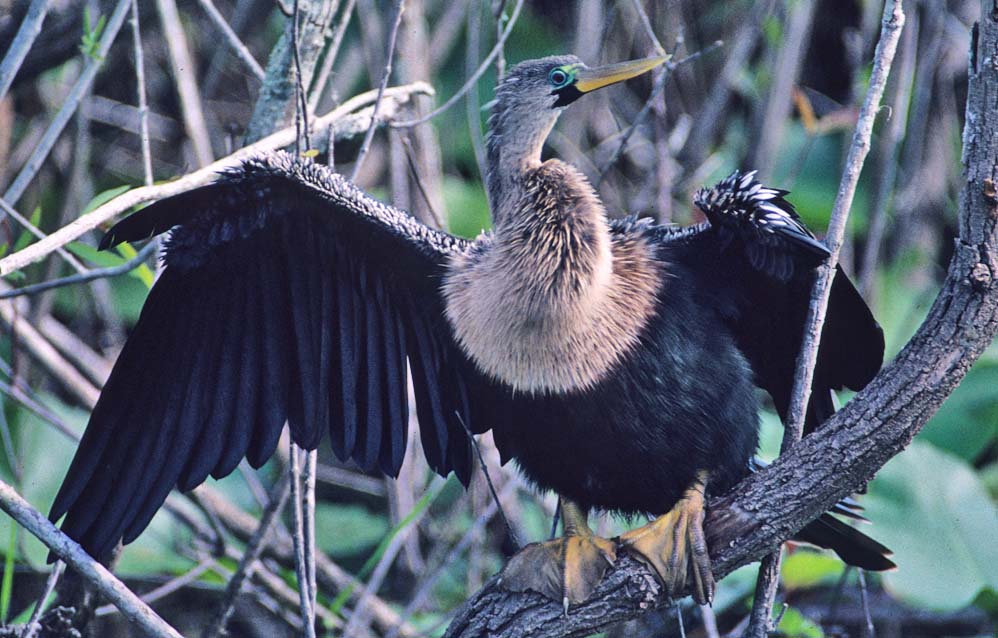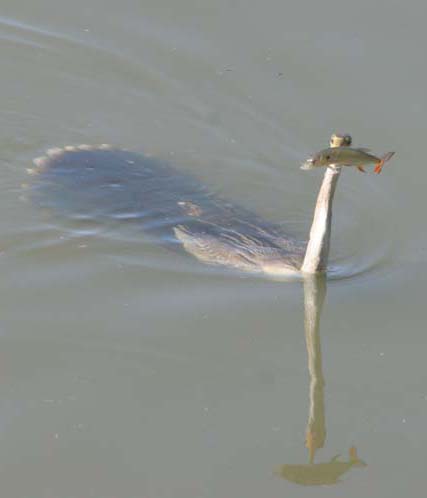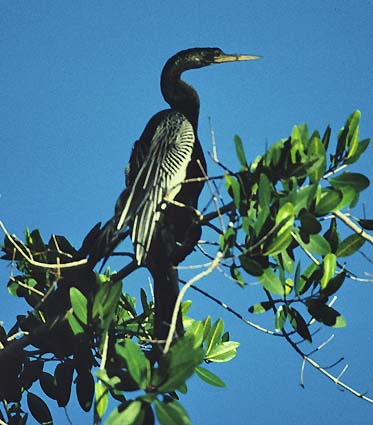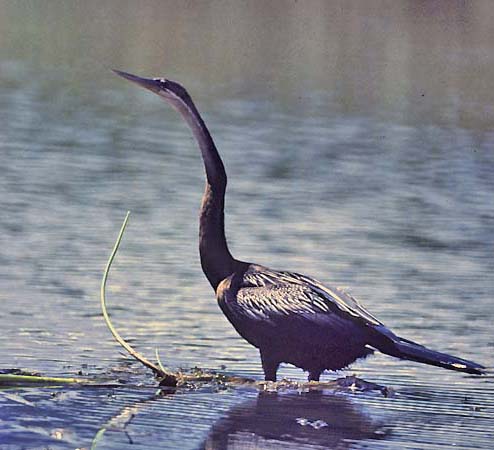
a web page by Don Roberson |
DARTERS Anhingidae |
||
|
||
In the New World there is one widespread species: Anhinga (left & below). This one, in the Brazilian Pantanal, has speared a fine fish (left) but had to deftly toss the fish into the air to position it for slide down the gullet (below). Note also the birds long, broad tail fanned out, helping it stabilize in the water for these acrobatics. |
||
 |
||
The New World Anhinga ranges from the Gulf Coast of the United States through Central America to the South American tropics as far south as Argentina. In the Old World, this fish-eating niche is filled by darters — very similar birds. For years there has been debate as to whether all the Old World darters are just one species (Anhinga melanogaster) or three species. The most recent Australian checklist and the 2011 version of Clements' checklist splits them into three:
The three darters are primarily identified by range, although there are variations in plumage details. Females most resemble males in Oriental Darter, and least resemble males in Australian Darter.
|
||
|
||
This groups has many adaptations for swimming, including large webbed feet (as can be seen on the Anhinga, below). The female is in full breeding condition with the bare facial patches flushing green. |
||
 |
||
Darters are monogamous, with pair bonds possibly lasting for years. They may reuse the same bulky nest each season. Nesting varies from solitary pairs to large colonies; in many tropical areas they form loose colonies for breeding. Chicks are hatched naked, and in these very early days they recall Spielberg's E.T. (below). See how tiny the little gnome looks beside the bulk of its parent. Within a few days, though, they are covered with fine white down. The parents feed them six times a day on regurgitated and semi-digested fish. Fights between siblings are frequent. Soon the chicks are old enough to jump into the water and swim or dive to escape danger. Barring that need, however, most remain in the nest for three weeks after hatching (Orta 1992). |
||
 |
||
Photos: The fish-catching Anhinga Anhinga anhinga (top two photos) was in the Pantanal, Mato Grosso, Brazil, on 20 July 2010; the adult male was in the mangroves of San Blas, Mexico, in Feb 1987. The Oriental Darter A. melanogaster was at Kaziranga NP, Assam, India, in Apr 2001. The African Darter A. rufa was on Lake Jipe, Kenya, in Nov 1981. The female Anhinga in breeding colors was at Everglades NP, Florida, USA, on 9 Jan 1999; the chick in nest was there in April 2000. The flying Anhinga and the other wing-drying bird were in the Brazilian Pantanal in July 2010. All photo © Don Roberson; all rights reserved. Bibliographic note: There is no "family book" per se, but an summary of this family, with some fine photos, is in Orta (1992). Literature cited:
|
 Darters
and Anhinga form a distinctive family of large fish-eating waterbirds.
They are most closely related to cormorants, but diverged at least 30
million years ago (Orta 1992). The bill is long and dagger-like, stuck
into a small head that almost indistinguishable from the long neck.
This long thin neck is a key character of the family. It is sometimes
all one sees of the bird, as when submerged only the neck, head, and
bill appear above the water. For this they were given the colloquial
name "snakebird."
Darters
and Anhinga form a distinctive family of large fish-eating waterbirds.
They are most closely related to cormorants, but diverged at least 30
million years ago (Orta 1992). The bill is long and dagger-like, stuck
into a small head that almost indistinguishable from the long neck.
This long thin neck is a key character of the family. It is sometimes
all one sees of the bird, as when submerged only the neck, head, and
bill appear above the water. For this they were given the colloquial
name "snakebird." Female
and young Anhingas are varying shades of brown, like the one above, but
males are mostly black (left). Adults of both sexes have a beautifully
patterned upperwing and back with black-edged white feathers and long
scapulars. For reasons I have yet to understand, there are places that
have many Anhingas — like the Pantanal — but in the dry season at
least, almost are in brown plumages.
Female
and young Anhingas are varying shades of brown, like the one above, but
males are mostly black (left). Adults of both sexes have a beautifully
patterned upperwing and back with black-edged white feathers and long
scapulars. For reasons I have yet to understand, there are places that
have many Anhingas — like the Pantanal — but in the dry season at
least, almost are in brown plumages.

 Members of the Anhingidae, like this female Anhinga
(left), are good fliers. They alternate powerful flapping flights with
glides, like many raptors, and use thermals for soaring up to
considerable height. The underwing coverts are composed of small
feathers, permitting one to easily observe the major wing bones in
flight.
Members of the Anhingidae, like this female Anhinga
(left), are good fliers. They alternate powerful flapping flights with
glides, like many raptors, and use thermals for soaring up to
considerable height. The underwing coverts are composed of small
feathers, permitting one to easily observe the major wing bones in
flight. Like
cormorants, an Anhinga's plumage quickly becomes wet when in the water,
due to the microscopic structure of the feathers, rather than any lack
of waterproofing. This permits them to quickly reduce their buoyancy
and diving is much easier. Anhingas and darters are even less buoyant
than cormorants, and their plumage soaks up three times as much water
(Orta 1992). Thus they spend a lot of time each day drying their wings.
This open-wing posture (right) is very typical of an Anhinga. Anhinga
and darters go through a complete molt after breeding, and drop all the
remiges at once, leaving them flightless for a short period, like ducks
and rails.
Like
cormorants, an Anhinga's plumage quickly becomes wet when in the water,
due to the microscopic structure of the feathers, rather than any lack
of waterproofing. This permits them to quickly reduce their buoyancy
and diving is much easier. Anhingas and darters are even less buoyant
than cormorants, and their plumage soaks up three times as much water
(Orta 1992). Thus they spend a lot of time each day drying their wings.
This open-wing posture (right) is very typical of an Anhinga. Anhinga
and darters go through a complete molt after breeding, and drop all the
remiges at once, leaving them flightless for a short period, like ducks
and rails.